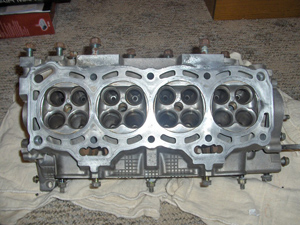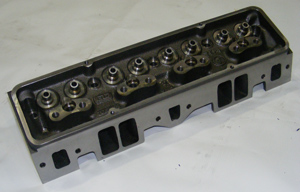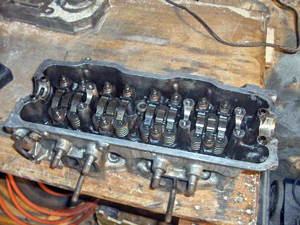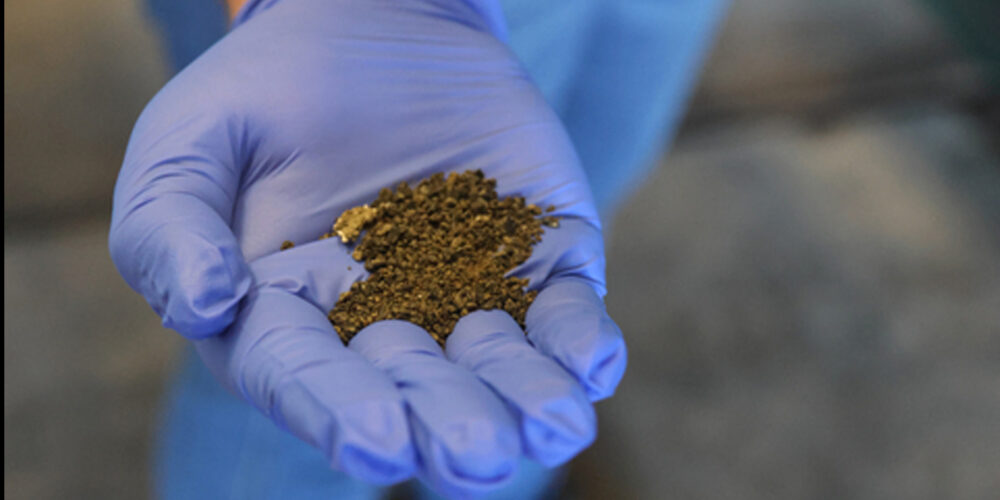By Brendan Baker
Senior Editor
ENGINE BULDER Magazine
Being an engine builder is like being a chef. As a master of culinary arts you may prepare the most exquisite meals anyone has ever tasted, but a great dining experience can be easily ruined if the vegetables are not thoroughly cleaned.
The same is true with engines. Cleaning cylinder heads may be one of the more thankless jobs your shop performs, and it often falls to the “new guy” or “the kid” to perform these tasks. However, as basic as it is, it’s a process not to be overlooked.
Whether you’re removing years of baked on sludge or cleaning a brand new cylinder head, they all must be cleaned thoroughly before being put back into service. As your mother may have told you when you were young: Cleanliness is next to Godliness. And in this case, it’s in your best interest to get the cylinder heads as clean as possible and avoid those costly comebacks or an engine failure during the big race.
 Cylinder heads have many blind passages and oil galleys that make them difficult to reach for cleaning by hand, let alone with an automated cleaning system. Because of the complex casting designs, cylinder heads require a more hands-on approach to cleaning and can present challenges to a high volume production environment.
Cylinder heads have many blind passages and oil galleys that make them difficult to reach for cleaning by hand, let alone with an automated cleaning system. Because of the complex casting designs, cylinder heads require a more hands-on approach to cleaning and can present challenges to a high volume production environment.
Certainly, there are considerations for thermal cleaning aluminum cylinder heads. Some engine builders say not to bake aluminum heads while others say it’s OK up to a certain point. You don’t want to expose aluminum heads to high temperatures for prolonged time periods or you might anneal (soften) the aluminum and have to start over with another head.
What it boils down to for many who do cleaning right is the right equipment, the right chemical and the right temperature at the right time.
For more and more engine builders, aqueous cleaning systems are the new standard as the old VOC (volatile organic compound) solvent systems of years past are made obsolete. VOC solvents are known to contribute to smog formation and may be toxic when inhaled. Solvents evaporate quickly, making worker exposure tough to control and monitor, and legal restrictions dictate how and where you can dispose of waste.
Today there is more attention to the environment, which in turn has affected the cleaning processes engine builders use in their shops. The challenge with most aqueous systems has been to find the best combination of cost-effectiveness, low-maintenance and evirionmental-friendliness.
According the U.S. Environmental Protection Agency (EPA) aqueous cleaners contain less than 5 percent (50 grams per liter) of VOCs. These are some of the reasons aqueous cleaning has gained a solid foothold in today’s engine rebuilding facility.
According to aqueous-cleaning equipment manufacturers, water-based detergents and washer systems clean just as effectively as solvents (as long as the equipment and cleaning solutions are maintained properly). And there are many different aqueous solutions available for cleaning all types of parts including cast-iron and aluminum cylinder heads. Detergent suppliers offer many formulations that work on both aluminum and cast iron.
 Manual cleaning systems are still in use today, but many shops use a water-based system instead of the old sink-on-a-drum VOC solvent system. A filtered stream of 100°-115° F aqueous cleaning solution flushes away dirt and oil as parts are cleaned with the familiar brush on the end of a hose. In some shops these drum and sink tanks are also being converted to bio-remediation systems. A bio-remediation system is a water-based solution that contains microbes, which are live organisms that eat oil. These live microbes break down and digest oils and other hydrocarbons, transforming grease and other gunk into water and carbon dioxide. However, the process is slow and requires maintaining the water temperature within a certain range, usually no hotter than 110° to 120° F, and replenishing the microbes regularly. This is the same principle that was used to clean up the Exxon Valdez oil tanker spill in 1999.
Manual cleaning systems are still in use today, but many shops use a water-based system instead of the old sink-on-a-drum VOC solvent system. A filtered stream of 100°-115° F aqueous cleaning solution flushes away dirt and oil as parts are cleaned with the familiar brush on the end of a hose. In some shops these drum and sink tanks are also being converted to bio-remediation systems. A bio-remediation system is a water-based solution that contains microbes, which are live organisms that eat oil. These live microbes break down and digest oils and other hydrocarbons, transforming grease and other gunk into water and carbon dioxide. However, the process is slow and requires maintaining the water temperature within a certain range, usually no hotter than 110° to 120° F, and replenishing the microbes regularly. This is the same principle that was used to clean up the Exxon Valdez oil tanker spill in 1999.
Immersion tanks are not as labor-intensive as the sink on drum setup. Shops have been using “hot tanks” for many years, where the cylinder head is immersed in a cleaning solution and a lift platform agitates up and down for more effectiveness. This type of system can also be used as a soak tank, which shops often use as an initial cleaning step.
In addition to a lift platform, a recirculating pump can be added to provide more turbulence to the tank. This moves the cleaning solution around in a circle inside the tank, creating additional scrubbing action. Immersion washers can be fairly effective on intricate parts such as cylinder heads and other parts with blind holes, channels, etc. The agitation process forces the cleaning solution into all the tight areas of the engine part.
A cabinet washer (often called a jet spray washer) is basically an industrial-strength dishwasher. Jet washers use a pattern of spray nozzles that spray cleaning solution with detergents under some pressure (typically 40-60 psi) onto the parts. The combination of water pressure impinging against the surface, and the secondary action of the water and detergent dispersing and rinsing away the contaminants does an effective job on most types of engine components.
In a typical jet spray washer system, the wash and rinse cycle may only take 10 to 15 minutes compared to hours of soaking in hot tank. Using jet spray washers and flow-through systems allows you to load the parts and walk away, eliminating the need for a lot of hand washing. This frees up time for other tasks such as machine work or assembly work, tasks that add more to the bottom line.
 The disadvantage of the spray cabinet washer for cylinder head cleaning is one of the biggest advantages of the immersion-type washer. The jet washer’s spray pattern cleans areas it hits very well. But it can’t get into tight areas like blind holes, for example. And if it can’t get in to an area, it just won’t clean. That’s why engine builders usually have to get in and “clean behind the ears.” Cylinder heads have many tough to reach areas and most automated systems can’t reach them all.
The disadvantage of the spray cabinet washer for cylinder head cleaning is one of the biggest advantages of the immersion-type washer. The jet washer’s spray pattern cleans areas it hits very well. But it can’t get into tight areas like blind holes, for example. And if it can’t get in to an area, it just won’t clean. That’s why engine builders usually have to get in and “clean behind the ears.” Cylinder heads have many tough to reach areas and most automated systems can’t reach them all.
Jet spray washers employ several nozzles around a stationary manifold system (although some part of the system usually rotates to reach more areas) to shoot water at the cylinder head(s) that are sitting on a turntable inside the washer cabinet.
High-pressure spray-booth systems operate similarly to glass bead systems and add increased cleaning capabilities over jet spray washers. They require manual operation and blast out between 400-600 psi of water pressure. This allows aqueous cleaning solution to clean parts such as cylinder heads with blind, tight areas with a high degree of impingement, meaning it will break through all the layers of crud.
Another type of cleaning system being used more and more in the automotive industry is the ultrasonic parts washer, which is very effective at removing carbon and burned on oils. The ultrasonic process is also particularly suited to cleaning blind holes and geometrically complex parts – again, well suited for cylinder head cleaning.
Ultrasonics works by using sound waves above the frequency normally considered audible for humans (above 18 Kilohertz). When high frequency vibrations are introduced into liquids, areas of extremely high vacuum and extremely high pressure are generated alternately at any given point in the liquid as the sound waves pass. The vacuum effect creates what is called a cavitation bubble. As positive pressure replaces the vacuum that formed the cavitation bubble, it collapses in implosion resulting in high-pressure shock waves, which does the work of scrubbing the part and pulling the debris away from the surface of the cylinder head. Energetic disturbances are generated by the implosions of countless cavitation bubbles. These perform the cleaning task by providing micro-agitation throughout the liquid volume.
With all aqueous-based cleaning processes, choosing the best detergent and/or chemical for the application is very important. The same equipment may give quite different results when different detergents are used. Some cleaning products are formulated for specific types of material such as aluminum or cast iron, while others are general-purpose cleaners. The best advice here is to follow the equipment suppliers’ recommendations for chemical usage.
Cleaning experts recommend using a milder or less aggressive cleaner on aluminum because some products designed for cleaning ferrous metals can etch or discolor aluminum making it difficult to achieve that bright finish many engine builders desire.
Depending on your needs, you may choose to invest in separate systems for cast iron and aluminum cleaning, because experts say no single product cleans everything equally well. However, some chemical suppliers say that the aluminum-safe detergents work well enough for both types of metal to use one chemical.
While most engine builders differ in many ways, some also use different cleaning techniques for different metals, using a spray washer for aluminum heads and an oven for cleaning cast iron heads. Others may use an oven to bake off grease and oil, and a spray washer, rather than a shot blaster to clean off the scale and ash left by the oven. Spray washers also seem to be a popular choice for final cleaning to remove oils and residue after cylinder heads have been machined.
For water to clean effectively, it usually needs heat. The recommended temperature range will vary according to the type of equipment and chemicals used, and may range from 105° up to 190° F. Many spray washers operate best in the 140° to 180° F range. If the water temperature is too hot, though, water loss resulting from evaporation may require adding “make-up” water to maintain the cleaning solution. Some equipment suppliers recommend a slightly lower water temperature when cleaning aluminum while others do not. Again, it’s what works best for your set of circumstances.
Maintenance includes adding make-up water as needed to compensate for water which is lost during cleaning operations and to evaporation, adding detergent and other chemicals such as rust inhibitors to maintain the proper detergent balance, replacing or cleaning filters and oil skimmers as needed to slow the buildup of contaminants, and periodically removing sludge and other solid matter that accumulates in the bottom of the cleaning equipment.
The key to successfully cleaning parts with most aqueous-based processes is keeping the water clean. Clean water is especially important in spray washers because dirty water can clog spray nozzles, reducing the overall cleaning effectiveness of the process. Spray washers and power washers depend mostly on the force of the water striking the surface to loosen and wash away dirt and grease, but many also rely on the detergent or other chemicals to complete the job.
The other key is to get rid of the dirty water in a safe manner. As the cleaning solution becomes dirty, it must eventually be treated or disposed of and replaced. That’s one of the drawbacks of any type of liquid cleaning process. Filters and skimmers can prolong the life of the solution, but cannot do so indefinitely unless other means are employed to treat and restore the solution.
Easy Bake Ovens Loaded with Airless Shot Blast
Thermal cleaning ovens have been used effectively for many years to clean cylinder heads and blocks. Oven cleaning has mainly been used on cast iron parts but it has also been used on aluminum components with good results. Some engine builders say they prefer the thermal method because it cleans parts that have a lot of soil without having to do as much hand cleaning.
Thermal cleaning creates a very clean finish on cylinder heads and blocks. In fact, creating the “new” finish is one of the primary goals for some engine builders because customers expect parts to look new. And for some types of cleaning systems, this new finish is a challenge. Some engine builders go as far as to paint the aluminum to achieve this new look. It is really up to you and what your customers want for a finished product.
The oven cleaning method involves more than simply heating a component in an oven. Thermal cleaning involves a two-step process that includes the oven (thermal step) followed by an airless shot-blasting step. The oven will bake all of the oils and grit out of the piece and turn it to dried ash, and the airless shot blaster knocks all of the ash off and produces the “new” look that so many are after.
Soda Blasting
One of the more effective methods for removing baked-on carbons and oils is with a soda blasting system. Soda media is a form of baking soda that has been developed for industrial use to remove stubborn contaminants. Makers of these systems say soda is much easier to use for removing hard carbons and baked on sludge since the media is water-soluble and there is no need to worry about it becoming trapped in hard to reach areas. Soda manufacturers say that this media is easier to use than other cleaning media and it eliminates other cleaning steps, therefore it’s more cost-effective for cleaning components such as cylinder heads, even though it is a “one-pass” medium. There are a number of systems that employ soda, but most engine builders use the cabinet style system, which is also similar to a glass bead cabinet. One soda manufacturer said that they are working on a wet-delivery system but haven’t yet released it to the public, so look for this in the near future.














